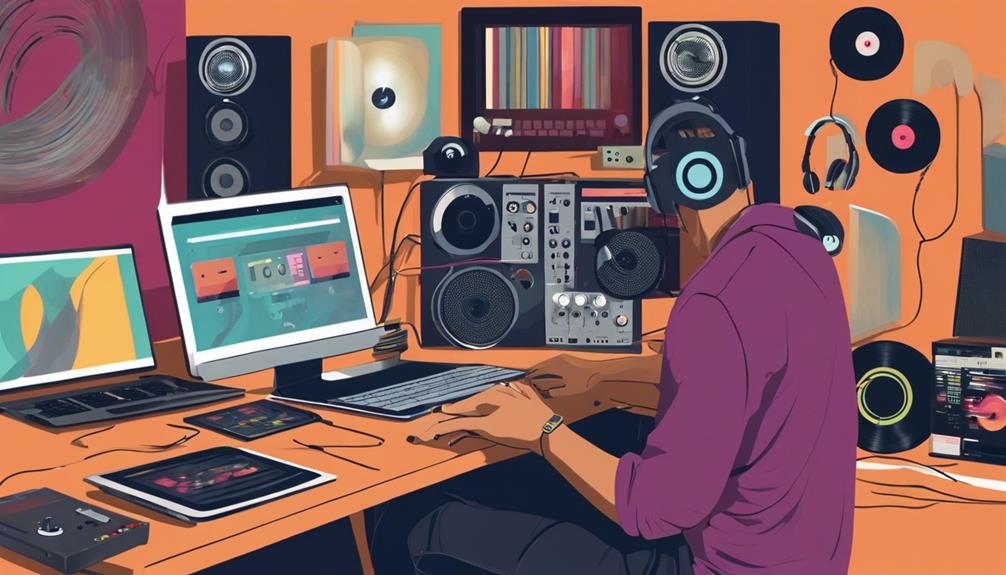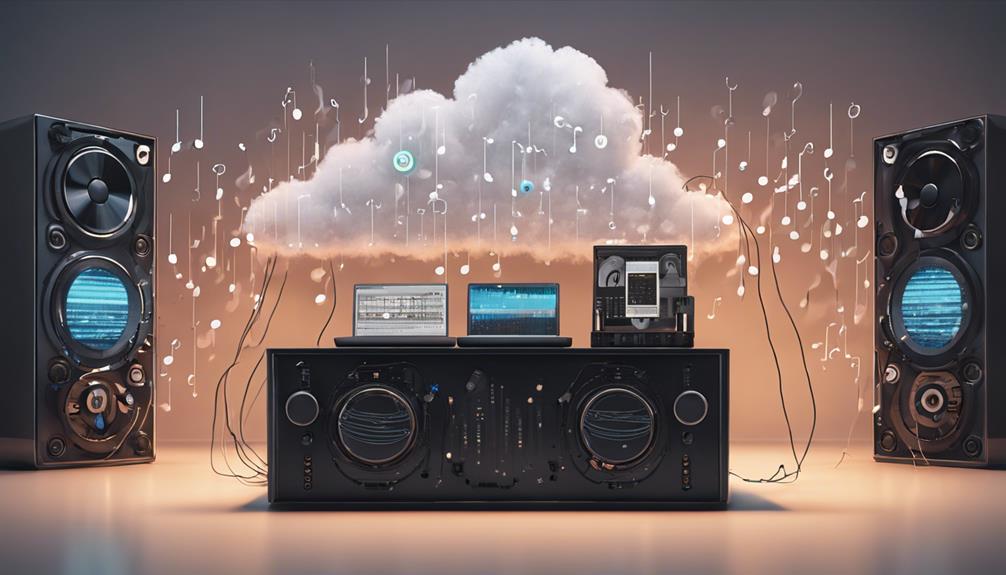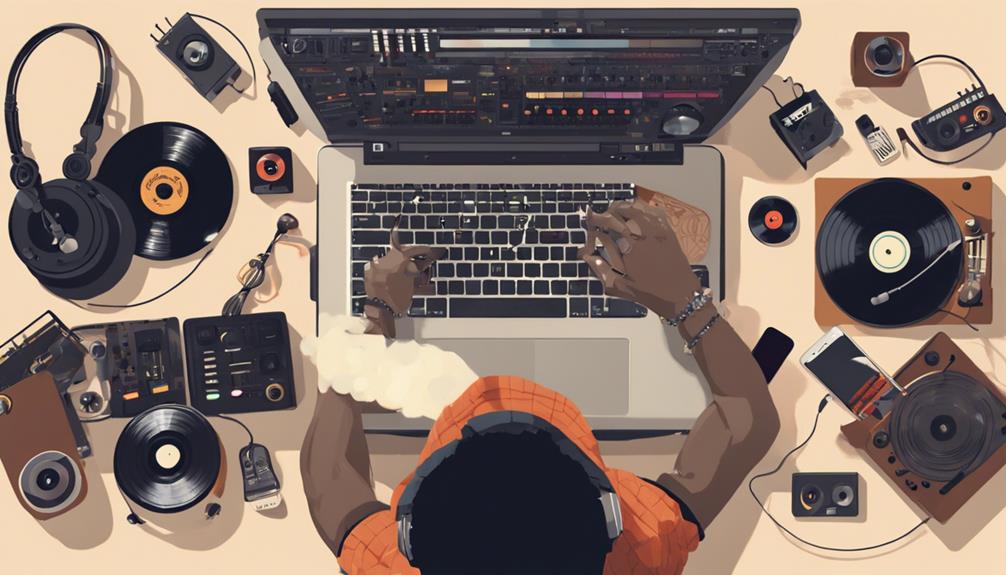No products in the cart.
To manage your extensive DJ music library efficiently, start by using management software like Serato DJ to organize tracks and create dynamic playlists. Establish a clear folder structure by genre and year for easy navigation. Always tag your tracks with smart metadata for swift searching and sorting. Keep your library fresh by regularly updating playlists and adding new music. Implement backups on external drives and cloud storage to safeguard your files. Utilize smart search features to quickly find tracks, and routinely clean up duplicates to optimize library space. Regular maintenance and strategic organization will transform your DJ sets, giving you even more control and creativity.
Key Takeaways
- Utilize software like Serato DJ for advanced track organization and dynamic playlist creation.
- Implement a clear and structured folder system, sorting music by genre, year, and mood.
- Regularly update and diversify your library to include new tracks and remove outdated ones.
- Employ metadata tagging for efficient searching and accurate track management.
- Backup your music library using both external hard drives and cloud storage for data security.
Utilize Music Management Software
Why not streamline your DJ music library management with software like Serato DJ, which offers powerful tools for organizing and accessing your tracks? By leveraging playlist customization, you can tailor your music selections to suit any event or mood. Serato DJ allows you to create dynamic playlists that adapt to your needs, making it easier to keep your performances fresh and engaging.
Furthermore, Serato DJ’s integration with cloud storage guarantees that your library is accessible no matter where you are. You don’t have to worry about leaving your favorite tracks behind; cloud synchronization lets you pull your playlists from any device, making sure you’re always prepared.
In addition to these features, effective track organization is made simple with Serato DJ’s metadata utilization. This means you can sort and search your tracks efficiently. You’ll find exactly what you need with just a few clicks, thanks to detailed tagging and categorization. Metadata also powers Serato DJ’s Smart Crates feature, which automatically updates your playlists based on the criteria you set, keeping your library organized and your sets innovative without constant manual adjustments.
Establish a Folder Structure
To effectively manage your DJ music library, start by creating a master folder as the main organizing hub. This master folder is where all your tracks will initially converge, providing a central point from which your entire library is accessible.
Next, implement a folder structure within this master folder based on genres. This method allows you to easily locate and access specific types of music. Label these primary genre folders with custom folder names that resonate with your understanding and style of music. It’s important that these names are both meaningful and clear to you, enhancing your workflow during live sets or when planning a session.
Further refine this organization by subdividing each genre folder by years. This approach helps in categorizing tracks more specifically, making it easier to pull up everything from classic hits to the latest tracks. Such chronological sorting can be invaluable during themed events or specific era-focused gigs.
Additionally, consider the importance of subgenre organization. Creating subfolders within each main genre can streamline your search for tracks that fit more specific vibes or crowds, providing nuanced control over your music selection. Remember, consistency and simplicity are your allies in maintaining a clear, navigable music library.
Analyze and Tag Tracks
As you manage your DJ music library, it’s essential to implement smart metadata tagging to streamline your workflow.
By enhancing genre classification and implementing energy level ratings, you’ll be able to quickly select the perfect track for any moment.
This organized approach not only saves you time during performances but also simplifies the process of creating impactful playlists.
Utilize Smart Metadata Tagging
Utilizing smart metadata tagging, you can analyze and label your tracks with essential details like BPM, key, genre, and mood, simplifying search and categorization in your music library.
By integrating automated tagging systems, you streamline your music organization strategies, ensuring every track is readily accessible.
Metadata customization allows you to adapt the information to your specific needs, enhancing your ability to quickly find the right track for any moment in a set.
Employing track analysis techniques further refines your library, making use of tools like Serato DJ, MP3Tag, or TagScanner to efficiently manage large volumes of music.
This organized approach saves you time and improves your performance by keeping your tracks well-coordinated and easy to navigate.
Enhance Genre Classification
Enhancing genre classification in your DJ music library involves analyzing tracks for key musical elements and using tagging tools for accurate and consistent genre assignment. You’ll want to focus on rhythm, instrumentation, and vocal style to determine the right genre. For a more refined approach, tag tracks with specific sub-genres like deep house, tech house, or progressive house. This not only improves genre consistency but also aids in establishing a clear genre hierarchy within your library.
Leverage music analysis software to streamline the genre tagging process. Such tools help in automating the identification, ensuring that every track is classified correctly, enhancing searchability and usability of your music collection. Remember, precise categorization is key to managing your library efficiently.
Implement Energy Level Ratings
To effectively manage your DJ sets, start by analyzing and tagging each track with an appropriate energy level rating such as ‘Low Energy,’ ‘Medium Energy,’ or ‘High Energy.’ This method allows you to create playlists that enhance the dynamics of your performance.
By categorizing tracks based on their energy levels, you can plan energy level progressions meticulously, ensuring your set flows smoothly from mellow moments to peak energy bursts.
Using these tags also simplifies flow management and facilitates seamless progressions between songs. You’ll find it easier to maintain the desired vibe and keep your audience engaged throughout the event.
Create Diverse Playlists
As you build your DJ music library, it’s essential to focus on genre-based sorting and mood-themed selections. This approach allows you to quickly adapt to the changing dynamics of an event and meet the varied tastes of your audience.
Genre-Based Sorting
Organizing your music by genre helps you craft diverse playlists that appeal to various musical tastes and event types. By categorizing your library into genre-specific folders, you’ll streamline track selection and enhance mixing. This method not only enhances shifts but also guarantees a coherent flow, essential for any DJ performance.
| Genre | Benefit |
|---|---|
| House | Energizes high-tempo sets |
| Jazz | Smooths downtempo moments |
| Hip-Hop | Engages crowd with lyrics |
| Electronic | Maintains energetic vibes |
Utilizing genre-based sorting allows you to create themed sets that cater specifically to your audience’s preferences. This approach is not just about playing music; it’s about creating an experience that resonates and keeps the energy flowing seamlessly throughout your event.
Mood-Themed Selections
Creating mood-themed playlists allows you to design diverse musical experiences that resonate with different audience emotions and event phases. By focusing on mood progression and tailoring the event atmosphere, you guarantee that your music selections enhance every moment.
Here’s how you can effectively manage these playlists:
- Categorize Tracks: Sort your music into categories like chill, energetic, nostalgic, and uplifting. This makes it easier to pull the right vibes at the right time.
- Plan Progressions: Seamlessly blend songs to guide the mood progression smoothly from calm to high-energy as the event unfolds.
- Update Regularly: Keep your playlists fresh and relevant by adding new tracks that fit the mood and removing ones that no longer work.
This approach keeps your sets dynamic and engaging, ensuring every event feels unique and tailored.
Regularly Update Your Library
To keep your performances dynamic and your playlists current, you should regularly update your DJ music library. This not only helps you stay in tune with the latest music trends but also opens doors to collaboration opportunities and music discovery. By consistently adding new tracks, you’re ensuring your sets remain fresh and engaging. This proactive approach leads directly to performance enhancements as you’re better prepared to meet the diverse and evolving tastes of your audience.
When it comes to playlist curation, updating your library plays an important role. It allows you to organize your tracks effectively, ensuring that you’re always ready with the perfect set for any event. Removing outdated or seldom-used songs will free up space and streamline your selection process, making your performance preparation both quicker and more efficient.
Here’s a quick breakdown of the benefits:
| Action | Benefit |
|---|---|
| Adding new tracks | Keeps sets engaging and current |
| Removing old tracks | Frees up space, streamlines library |
| Regular updates | Stays aligned with music trends |
Regular updates are essential not just for maintaining relevance but also for your growth and adaptability as a DJ.
Backup Your Music Files
After updating your DJ music library, it’s equally important to back up your music files to safeguard your collection. Data loss can be devastating, and with hard drive lifespan being a concern, it’s essential to incorporate effective data loss prevention strategies.
Here are three key steps to make sure your music files are secure:
- Utilize External Hard Drives: Invest in high-quality external hard drives for physical backup. Remember, these drives have a limited lifespan, typically around 3-5 years, so it’s wise to replace them periodically to prevent data loss.
- Leverage Cloud Storage Solutions: Cloud storage solutions like iCloud or Google Drive offer an extra layer of data security. They not only provide convenient access to your files from any location but also serve as an additional backup in case your physical drives fail.
- Combine Both Methods: For the most thorough protection, maintain both cloud and physical backups. This dual approach minimizes risks and ensures you have multiple recovery options.
Securing your hard drive with Velcro strips to your laptop can also prevent accidental disconnections, enhancing the stability of your backup process. Always prioritize the security and accessibility of your music files to keep your performances running smoothly.
Sort Music by Energy Levels
Sorting your DJ tracks by energy levels can transform an ordinary set into an unforgettable live experience. By understanding and organizing your music according to the intensity and vibe of each track, you’re better equipped to manage the energy dynamics of your performance. This method allows you to seamlessly shift from chill to warm-up, peak, and finally to cooldown phases, maintaining a smooth flow that keeps your audience engaged.
When you categorize your music library by energy levels, you’re not just playing songs; you’re curating an experience. Start by listening to each track and assigning it to a specific category. This might seem meticulous, but it’s essential for maintaining vibe variations throughout your set. Matching energy levels between tracks ensures that the connections aren’t only smooth but also feel intentional and thoughtful, enhancing the overall atmosphere.
Implement Smart Search Features
To manage your DJ music library more effectively, you should utilize advanced filtering options that allow you to sift through tracks based on specific criteria like BPM or genre.
Ensuring the precision of metadata across your music files will greatly enhance the efficacy of these search tools.
Additionally, adopting a keyword tagging system can streamline your track selection process, making it quicker to locate the perfect song for any set.
Utilize Advanced Filtering Options
Utilizing advanced filtering options, you can streamline your search by selecting tracks based on BPM, key, and genre, enhancing your ability to craft the perfect playlist. These smart search features are essential for effective DJing, allowing you to focus more on:
- Harmonic mixing: Quickly find tracks in compatible keys to guarantee smooth blending.
- Tempo matching: Filter songs by BPM to align with the energy level of your current set effortlessly.
- Dynamic playlist creation: Tailor your music selections to suit the mood or theme of any event.
Enhance Metadata Accuracy
By enhancing metadata accuracy through smart search features, you’ll greatly improve your music library’s organization and retrieval efficiency. Utilize software tools that offer advanced search capabilities, focusing on detailed metadata to optimize organization and improve searchability.
Consistent and precise metadata tagging is essential; it guarantees you can quickly find specific tracks based on criteria like BPM, genre, or key without hassle. This precision not only aids in swiftly locating songs but also enhances your ability to create dynamic playlists tailored to any DJ set.
Implementing these smart search features streamlines your workflow and boosts your performance capabilities, making every gig smoother and more enjoyable. Remember, good metadata is key to a well-organized music library.
Adopt Keyword Tagging Systems
Adopting a keyword tagging system allows you to efficiently categorize and access your music tracks by assigning custom tags that reflect mood, energy level, or event type. Here are three reasons why you should use customizable tags for efficient organization:
- Quick Access to Music: By tagging each track, you’ll streamline your search process, enabling you to find the perfect song in seconds.
- Dynamic Playlists: Easily create playlists that are tailored to specific audiences or events, enhancing your performance and audience engagement.
- Consistent Categorization: Maintain a uniform tagging method across your library, making it easier to manage large volumes of tracks.
With smart search features, you’ll transform your music library into a well-oiled machine that keeps up with your creative demands.
Clean Up Duplicate Tracks
To effectively manage your DJ music library, start by using tools like Duplicate Cleaner or Gemini 2 to identify and eliminate duplicate tracks. These tools simplify the track analysis process, ensuring you’re not wasting time manually sifting through your collection. Regularly scanning for duplicates not only keeps your library organized but also enhances storage optimization by clearing out unnecessary files.
Duplicate tracks clutter your system and degrade its performance. By removing them, you’ll free up essential storage space, allowing your software to run more smoothly and load tracks faster during your sets. It’s important to integrate this cleanup process into your routine to maintain a streamlined collection.
Consider setting up automated features available in many music management software programs. These can detect and remove duplicates periodically without your constant oversight, saving you time and effort. This proactive approach prevents the accumulation of duplicates, ensuring your library remains in top shape and ready for any gig.
Review and Refine Periodically
After cleaning up duplicate tracks, you should regularly review and refine your music library to keep it efficient and well-organized. This process is vital in maintaining a streamlined collection that reflects your current DJing style and preferences. Here are some steps to help you in this ongoing task:
- Update Metadata and Tags: Make sure all your tracks have accurate metadata, including artist names, track titles, and genres. This makes track selection more intuitive and your library curation more precise.
- Assess and Adjust Your Playlists: As your musical taste evolves, so should your playlists. Periodically re-evaluate them to include new finds and remove tracks that no longer fit your style. This dynamic approach keeps your performances fresh and engaging.
- Organize Library Structure: Take time to analyze how your tracks are organized. Could a different structure improve your workflow? Maybe grouping by mood or energy level instead of just genre or artist will enhance how you manage and use your collection.
Frequently Asked Questions
What Is the Best Way to Organize DJ Music Library?
To best organize your DJ music library, focus on genre categorization and BPM sorting. Use smart playlists and maintain consistent metadata for seamless navigation and efficient set planning.
How Do You Organize a Massive Music Library?
To organize a massive music library, you’ll categorize tracks by genre and tag each playlist meticulously. Regularly update and refine your tags to keep everything accessible and streamlined for quick selection.
What Is the Best Music Library Manager for Djs?
The best music library manager for DJs is Serato DJ. Its robust software features and positive user reviews highlight its efficiency in organizing and managing large collections with advanced metadata and Smart Crates.
How to Organize Library DJ Reddit?
To organize your DJ library on Reddit, start by creating genre playlists. Engage with the community for feedback and recommendations on structuring your tracks for best performance and easier navigation.
Conclusion
You’ve got the tools to master your DJ music library! Start by leveraging powerful music management software to streamline your process. Organize your tracks with a clear folder structure and keep your library fresh by regularly updating and tagging your music. Don’t forget to delete duplicates and refine your playlists periodically.
By following these steps, you’ll enhance your performance and guarantee your music collection is both manageable and impressive. Now, go spin that deck with confidence!




